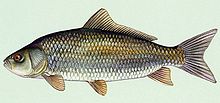Bigmouth buffalo
| Bigmouth buffalo | |
|---|---|
 |
|
| Scientific classification | |
| Kingdom: | Animalia |
| Phylum: | Chordata |
| Class: | Actinopterygii |
| Order: | Cypriniformes |
| Family: | Catostomidae |
| Genus: | Ictiobus |
| Species: | I. cyprinellus |
| Binomial name | |
|
Ictiobus cyprinellus (Valenciennes, 1844) |
|
| Synonyms | |
|
|
The bigmouth buffalo (Ictiobus cyprinellus) also known as the gourd head, redmouth buffalo, buffalo fish, bernard buffalo, roundhead, or brown buffalo, is a large species of the Catostomidae or "sucker" family.
The bigmouth buffalo is a dull brownish olive color with dusky fins. Like other suckers it has a long dorsal fin, but unlike others it has a large oblique and terminal mouth. It is the largest of the buffalo fish and reaches a length of more than 4 ft (1.2 m) and 65 lb (29 kg) in weight.
It is distributed from the Red River of the North, Manitoba, Canada and North Dakota, United States to the Ohio River and south in the Mississippi River system to Texas and Alabama in the United States. It lives in sluggish areas of large rivers and shallow lakes and streams.
The bigmouth buffalo migrates upstream to spawn in the spring, usually April to June where it lays its eggs on plants to which they adhere. Bigmouth buffalo, unlike its close relatives the black and smallmouth buffalos, is a filter-feeder, using its very fine gill rakers to strain crustacean zooplankton from the water. It sometimes feeds near the bottom, using short up-and down movements to swirl the water and thus be able to filter from the water the plants and animals that hover near the bottom or rest lightly on it (Pflieger 1997). More than one male will assist in spawning by moving the female to the top of the water to help mix eggs and milt. Spawn is usually April–May.
The fish is vulnerable in shallow water and is often captured by spearing. It is commercially caught on trot lines, setlines, hoop and trammel nets, and seines. Though it has numerous small bones, its good flavor makes it one of the most valuable of the non-game freshwater fish.
This is a description of a monitoring plan for the bigmouth buffalo, Ictiobus cyprinellus, and a short life history of the fish and previous management done. The bigmouth buffalo is naturally found throughout the United States from the Great Lakes south to Alabama and Louisiana drainages and west to Texas and Minnesota. They generally live in shallow swells, large slow-moving rivers or swamps since they seem to be adept at dealing with these low oxygen type habitats. This species of buffalo spawn in rock and gravel (open substratum) and have pelagic free embryos which they lay sometime in the spring. Populations of the bigmouth buffalo are currently shown as stable. The bigmouth buffalo is a popular foodfish throughout the United States and has been introduced into multiple states. There does not seem to be any considerable impact on their population that would harm their population numbers drastically in the near future. There are certain ecological needs that the bigmouth have in order to live though. They prefer shallow, slow-moving water like flooded vegetation. Bigmouth buffalo are also susceptible to anchor parasites which can lead to secondary infections which can be harmful in poor water conditions. Future management plans may need to include a treatment of major bigmouth buffalo habitats for these parasites if they become more abundant. In some areas of its distribution bigmouth buffalo may present a problem with overpopulation, there have been studies done on the effectiveness of electrical barriers in Lake Heron to decrease the population. A way to maintain the current populations or decrease them will certainly be a potential management need in the future for certain areas if cases like Lake Heron become more common.
...
Wikipedia

